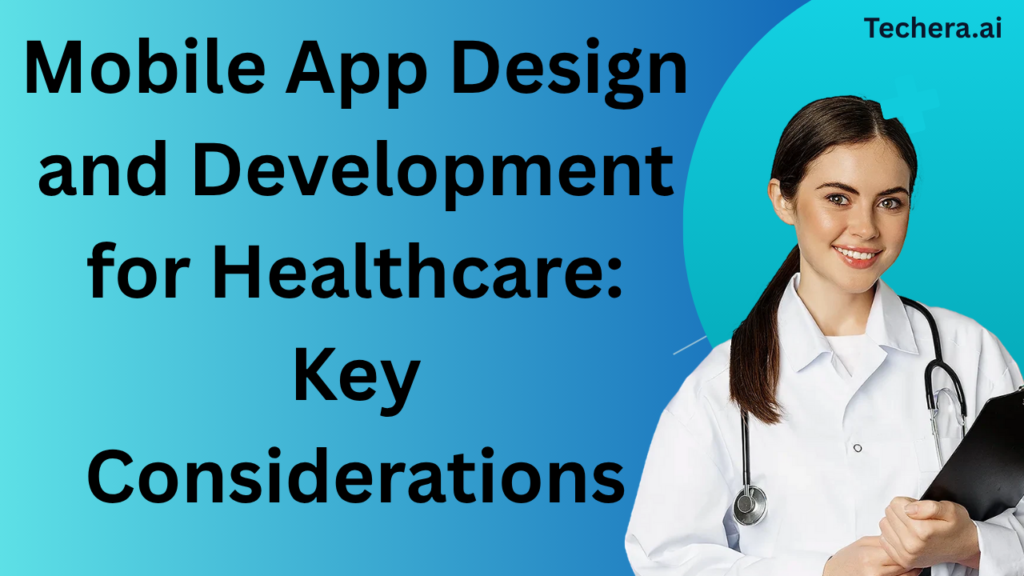
Discover essential factors for successful mobile app design and development in the healthcare sector. This post covers user-centric design, security compliance, and innovative features that enhance patient care and improve medical service delivery.
Introduction
Healthcare on phones is no longer futuristic — it’s everyday reality. From booking doctor appointments to continuous glucose monitoring and virtual consults, mobile health (mHealth) apps are changing how care is delivered and experienced. But healthcare apps are different from consumer apps: they carry clinical risk, regulatory obligations, and high user expectations. This guide walks you through the key considerations you must keep top-of-mind when Mobile app Design and Development healthcare mobile apps—so your product is effective, safe, and trusted.
Understanding the Healthcare Context
Before you sketch a single screen, understand the world your app will live in.
Regulatory landscape
Healthcare is heavily regulated. In the US, HIPAA mandates how Protected Health Information (PHI) is handled. In the EU, GDPR governs personal data and privacy. Many countries have their own laws and digital health guidance. Regulations affect data storage, consent, breach notification, and more. Early legal input avoids rework.
Clinical workflows vs. consumer workflows
Clinicians and patients interact with apps for very different reasons. Clinicians need efficiency, clarity, and integration with clinical records. Patients need empathy, simplicity, and reassurance. Map both workflows early to identify friction points and integration needs.
Defining Clear Objectives and Use Cases
Start with outcomes, not features.
Primary goals
Define what problem you’re solving: Is it telemedicine? Chronic disease monitoring? Medication adherence? Administrative automation? Each goal has different design and technical requirements.
User stories and personas
Create concrete personas: “Maya, 67, Type 2 diabetic, low tech confidence” or “Dr. Chen, cardiologist needing quick ECG review.” Use those stories to validate features, prioritize MVP scope, and guide testing.
User-Centered Design (UCD) Principles
Design around real users—especially in health, where stakes are personal and high.
Empathy and accessibility
Interview patients and clinicians. Observe their environments—noisy clinics, small screens, shaky hands. Design for those conditions. Accessibility is not optional: it’s an ethical and often regulatory requirement.
Designing for diverse users
Account for age-related needs (vision, dexterity), limited literacy, multilingual requirements, and assistive technologies (screen readers, switch controls).
Information Architecture & Navigation
Good IA reduces task time and errors.
Logical content organization
Group related features (e.g., “My Records,” “Messages,” “Appointments”) and make the path to critical actions obvious. Avoid burying urgent actions behind multiple menus.
Minimizing cognitive load
Healthcare users often operate under stress. Use progressive disclosure: show only what’s necessary for the current task. Break long forms into steps and use clear labels.
User Interface (UI) Best Practices
UI matters more in healthcare because clarity equals safety.
Visual hierarchy and clarity
Use typographic scale and spacing to guide attention. Important items (e.g., medication reminders, alerts) should stand out but not be alarmist.
Touch targets, typography, color, and iconography
Adhere to platform guidelines: minimum 44–48px touch targets, legible font sizes, and high contrast. Icons must be intuitive—always pair with labels.
Microinteractions and feedback
Small animations and confirmations (e.g., “Medication logged”) reassure users and reduce anxiety. Provide clear progress indicators for tasks that take time (uploading data, syncing).
User Experience (UX) Considerations Specific to Healthcare
Healthcare UX must support accuracy and trust.
Reducing friction in data entry
Let users upload photos, use voice-to-text, or pick from smart suggestions instead of typing long text. Auto-fill known information where appropriate.
Onboarding and consent flows
Walk users through data use, permissions, and privacy in plain language. Use layered consent—short summary first, detailed info available if they want it.
Also read Mobile App Design and Development for Startups: A Step-by-Step Approach
Error states and recovery
Errors will happen. Make messages actionable: “We couldn’t upload your file — try again or check your connection.” Log relevant errors for troubleshooting without exposing sensitive data.
Security & Privacy by Design
Security is foundational, not an add-on.
Data minimization and secure storage
Collect only the data you need. Store PHI encrypted at rest, and use secure key management. If you don’t need exact identifiers on the server, avoid storing them.
Authentication
Implement strong authentication: password complexity, rate limits, lockouts, and ideally multi-factor authentication (MFA). Biometrics (fingerprint/Face ID) improve usability and security.
Encryption in transit and at rest
Use TLS 1.2+ for network communications and robust algorithms (e.g., AES-256) for storage. Never transmit PHI in clear text.
Compliance & Legal Requirements
Meeting legal requirements reduces risk and builds trust.
Medical device classification
Some Mobile app Design and Development are considered medical devices (e.g., those that diagnose, predict, or treat conditions). If applicable, plan for FDA (US) or CE (EU) approvals early—these processes affect timelines and costs.
Documentation and audit trails
Keep detailed technical documentation, data flow diagrams, and change logs. Maintain audit trails for access and changes to PHI—this supports compliance and incident response.
Interoperability & Data Standards
Healthcare data plays best when it speaks standard languages.
FHIR, HL7, DICOM basics
FHIR (Fast Healthcare Interoperability Resources) is now the lingua franca for exchanging clinical data. HL7 and DICOM remain important for older systems and imaging. Designing with these standards dramatically eases integration with EHRs.
APIs and EHR integration
Expose and consume secure, documented APIs. Plan for varied authentication (OAuth2) and consent models. Test integrations with real EHRs or valid simulators.
Performance, Reliability & Offline Support
Apps must be fast and predictable—even in bad networks.
Low-latency, battery-friendly design
Optimize network calls, batch transmissions, and use push notifications wisely. Minimize background work that drains battery.
Offline strategies
Allow critical workflows (e.g., viewing last vitals, entering symptom logs) to work offline and sync when online. Use conflict resolution strategies to handle concurrent edits.
Testing Strategies for Healthcare Apps
Testing is broader than functional checks in healthcare.
Usability testing with real users
Conduct sessions with patients and clinicians across demographics. Observe where they hesitate or make mistakes and iterate.
Clinical validation and QA
If your app delivers clinical recommendations, validate against clinical standards, run pilot studies, and involve medical professionals in QA. Define acceptance criteria that include clinical accuracy, not just technical correctness.
Security testing
Penetration testing and code reviews are mandatory. Conduct threat modeling early and remediate identified risks. Consider third-party security audits for credibility.
Deployment, Maintenance & Monitoring
Launch is just the beginning.
Distribution channels
Decide between public app stores or enterprise distribution (MDM) for hospitals. Each has approval requirements and update mechanics.
CI/CD and versioning
Automate builds, tests, and deployments. Tag releases with clear versioning and maintain change logs for auditors and users.
Monitoring and incident response
Implement application performance monitoring (APM), crash reporting, and audit logs. Have a documented incident response plan for breaches or critical failures.
Ethics, Bias, and Responsible AI
If your app uses algorithms, be responsible.
Fairness and bias
Healthcare models can inherit biases from training data. Evaluate model performance across subgroups and don’t deploy black-box models without human oversight.
Explainability and human-in-the-loop
Provide explanations for recommendations and allow clinicians to override automated outputs. Maintain clear accountability for clinical decisions.
Accessibility & Inclusive Design
Make your Mobile app Design and Development usable by as many people as possible.
WCAG and platform accessibility
Follow WCAG 2.1 AA where applicable. Use semantic elements, proper labels, and test with screen readers.
Voice interfaces and large fonts
Offer voice guidance, adjustable font sizes, and high-contrast themes. Consider simple mode UI for users who want minimal complexity.
Patient Engagement & Behavior Change Techniques
Health outcomes often depend on consistent behavior. Design to encourage it.
Reminders and nudges
Use smart reminders for meds, appointments, and check-ins. Timing and tone matter—personalized, empathetic messages outperform generic spammy pushes.
Gamification and education
Incorporate progress bars, streaks, and small rewards to incentivize adherence. Combine with bite-sized educational content that empowers users.
Measuring outcomes
Track clinically relevant metrics (e.g., HbA1c levels, blood pressure) and engagement KPIs. Tie app usage to real-world outcomes where possible to demonstrate value.
Business Models & Monetization
Sustainability matters—pick a model aligned with stakeholders.
Subscription and B2B
Direct-to-consumer subscriptions work for consumer wellness apps. For clinical tools, partnering with providers, payers, or employers is common.
Payer integrations and value propositions
Demonstrate cost savings or improved outcomes to get payers on board. Value-based pricing often requires evidence from pilots or studies.
Case Studies / Example Features
Concrete examples help translate concepts into reality.
Remote Patient Monitoring (RPM)
Example: a hypertension RPM app collects home BP readings via Bluetooth cuff, flags abnormal values, sends automated educational tips, and routes critical alerts to nurses. Key needs: device pairing, data validation, secure storage, and clinician dashboards.
Telehealth Consultation Flow
Example: patient books an appointment, completes pre-visit questionnaire, uploads symptoms/photos, joins a secure video call, and receives e-prescription. Key needs: scheduling sync with clinicians’ calendars, secure video, e-prescribing integration, and visit summary generation.
Checklist: Pre-launch and Post-launch
Pre-launch
- Validate user needs and clinical use cases.
- Legal review for compliance and device classification.
- Threat model and security baseline.
- Usability testing with target users.
- Integration tests with EHR/APIs.
- Documentation and privacy policy ready.
Post-launch
- Monitor crashes, errors, and usage.
- Collect feedback and run rapid UX iterations.
- Conduct clinical evaluations or pilots to prove outcomes.
- Update security patches and dependencies regularly.
- Maintain incident response and breach notification readiness.
Conclusion
Mobile app Design and Development healthcare apps is a multidisciplinary challenge. You must blend empathetic design, clinical accuracy, airtight security, and regulatory savvy. Begin with a clear problem statement, involve real users and clinicians early, adopt standards like FHIR for interoperability, and bake security and privacy into every decision. When done well, healthcare mobile apps can increase access, improve outcomes, and make care more humane. But because the stakes are high, rigorous testing, responsible AI practices, and ongoing monitoring aren’t optional—they’re essential.
FAQs
1. Do I need to make my healthcare app HIPAA-compliant?
If your app handles Protected Health Information (PHI) of U.S. patients or interacts with covered entities (providers, payers), yes—HIPAA compliance is required. Outside the U.S., similar regulations like GDPR may apply.
2. Should I use FHIR for data exchange?
Yes. FHIR is widely adopted and simplifies integration with modern EHRs, reducing development friction and future-proofing interoperability.
3. How do I know my app is a medical device?
If your app performs diagnosis, makes treatment recommendations, or controls medical devices, it may be classified as a medical device. Consult local regulators (e.g., FDA, EMA) early to determine classification and required approvals.
4. Can I use AI/ML in my app for clinical decision support?
You can, but be cautious—validate models with diverse datasets, evaluate for bias, provide explainability, and include human oversight. Regulatory scrutiny increases with the clinical impact of the AI.
5. What’s the best way to involve clinicians in the design process?
Engage them as co-designers: run workshops, shadow clinical workflows, use prototypes in simulated environments, and include them in acceptance testing. Their input shapes safe and usable solutions.

